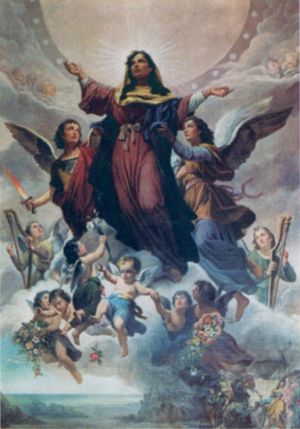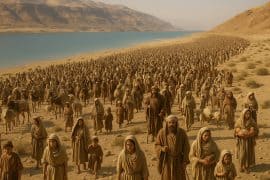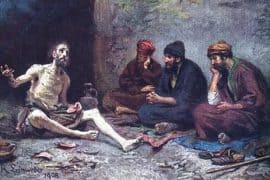Our Gospels present us with not only a profoundly “male” story, but it is also a profoundly asexual one.
Theology is one thing, history is another, and on these matters of sex, birth, and death there can clearly be a conflict but little contest.
I have written a variety of posts on this blog on Mary the mother of Jesus being a Jewish woman who bore at least seven children, see “Mary–Mother of God or Jewish Mother of Seven” and “Hearing from Mother Mary.” I have also posted an extended series on the possibility of Jesus having been married with children, see “A Married Jesus: Why I Changed My Mind.”
Although the scholarly debates on the evidence for either of these views are fascinating to follow, one senses on this topic–perhaps more than any other– that there are prejudices and assumptions at work in the minds of millions of people that immediately shut out even the possibility thereof. This perspective is deeply rooted in what we scholars call a “world-denying,” in contrast to a “world-affirming,” perspective. It seems that most religious traditions, both East and West, are much about denying this world for a better and higher spiritual world to come. It is, as we often say, in our mother’s milk. What I am about to write here could have gotten me killed in a culture and time not so distant, and even today this topic draws its share of angry treats and abusive language.

In the time of Jesus this world-denying proclivity found its expression in various forms of Hellenistic dualism and whether ones focus is on Jews, Christians, or pagans, such a world view seems ubiquitous, from Pythagoras and Plato to Philo and Paul. Some illustrative texts you can read here.
In this view reality, or the “creation,” is sharply divided into two separate opposing realms. These can be characterized by a series of contrasting and non-intersecting opposites:
Material/Spiritual
Earthly/Heavenly
Visible/Invisible
Human/Divine
Mortal Body/Immortal Soul
Death/Eternal Life
Decay/Incorruption
In such a dualistic scheme of things there is a real problem with explaining the origin of the lower material world into which we as humans are born, as well as proposing a lifestyle that would set one on the proper course of disengagement and devaluation of the physical world, in favor of the higher and better world above. After all, humans, with their decidedly “animal” bodies, are born into a world of death, so that the divine nature within them is seen as “trapped” “imprisoned” or “fallen” into such a lower realm. In the more extreme dualistic systems, often characterized as gnostic, the creation itself is seen as the work of a lower inferior god or angelic power, not the work of the supreme God who could have no part in creating such an inferior realm, and much less in placing humans in such a hopeless state.
Asceticism, or the denial of the material world and the desires of the physical body, was seen as the highest form of spirituality in that humans could shun sexuality and the pleasures of the body, detaching themselves from all that is below, in preparation for their eternal life in heaven. Birth and life in this world could be seen, ironically, as “death,” while death could be labeled as “birth,” into the higher spiritual world, a transit and escape from the lower realm.
Thus the philosopher Empedecles, wrote of his own birth, metaphorically imagining his soul’s entrance into this world, “I wept, I wept, when I saw this dreadful place!” And the apostle Paul, a dedicated sexual ascetic himself, exhorts his followers: “For we look not to the things that are seen, but to the things that are unseen; for the things that are seen are transient, but the things that are unseen are eternal.” He speaks of our “bodies of humiliation” and imagines life in a transformed heavenly body, free of decay, and of course, of sensuality and especially sexuality.
This ascetic dualistic perspective is so ingrained in our cultural baggage that it is equated by most with religion and spirituality itself.
Accordingly, Jesus understood as “God in the flesh,” and Mary his mother, as the “holy mother of God” are immediately put in tension with the clear teaching of the church that both Jesus and Mary were fully human. If “incarnation” is taken seriously, in its full implications, Jesus and Mary, as subject and vehicle of this merger of the divine and the human, have to remain “human”–or almost so. But therein lies the problem. To what degree can “the divine” truly participate in the human? An ascetic lifestyle is a given, and was widely admired through the Hellenistic-Roman culture. But what about sex and death? Those were the sticklers. Christians had a tremendous problem with imagining Jesus or his mother as sexual beings, so the idea of the perpetual virginity of Mary and the celibate Jesus go hand in hand. And for Jesus, and later his mother, to die and be buried, their bodies rotting and decaying, and going back to the dust, as with every other human being, became a problem as well. Heavenly life, for them at least, was finally seen to involve an “assumption” of their physical bodies, made incorruptible, directly into heaven, so that there could be no earthly remains.

Assumption by Venuti, Malta, 1896
That is why the Talpiot Jesus tomb (see my summary post “In-Depth Reading on the Talpiot Jesus Family Tomb“) is such a potential scandal to millions of Christians. If it could indeed be shown that the bones of Jesus were found in an ossuary, that he had a wife and a child, and that Mary, his mother, bore other children, and her bones were also buried with her son, then for many the whole structure of Christianity is threatened. Notions of perpetual virginity, lifelong celibacy, and bodily resurrection and/or assumption into heaven would each be called into question.
Of course Protestants and Roman Catholics do not agree on all these matters. Although Luther and the Reformers did argue for the perpetual virginity of Mary, it is common to hear Evangelical Christians say they have no problem with Mary living a normal sexual life and having other children. And Protestants have never had a problem with finding the bones of Mary, who is assumed to have died and returned to the dust. But Jesus of course is another matter. I believe there is a deep seated aversion to thinking of Jesus as living a normal sexual life. What one might hear is that we have no “historical record” of Jesus having a wife or children, but it is clear to me, having grown up in conservative Christian circles, that much more is at stake on the “gut” level. As “fully human” as Jesus might have been, one does not get far imagining the Son of God being aroused sexually and having intercourse. Even to write of such things, as I am doing here, is just considered inappropriate and in bad taste. And how much more so for his mother? If we don’t like to think of our own parents having sex, then all the more so for the Holy Family, one and all. Perhaps that is why the wives and children of none of the apostles or brothers of Jesus are ever named in our Gospel records. Our Gospels present us with not only a profoundly “male” story, but it is also a profoundly asexual one.
But what was the reality?
Historians are left to deal with the social, cultural, and religious world of 1st century Roman occupied Jewish Palestine when they deal with any historical figure of the period, and Jesus all the more so, since understanding him in his own time and place has such an impact on our lives today. In that world of historical reality humans have fathers, and only in mythological stories, not to be taken literally, are they fathered by gods; men and women marry and have children, it is the cultural norm; and humans die and are buried together in tombs, with their bones being collected in various ways by the living in memory of the dead. Theology is one thing, history is another, and on these matters of sex, birth, and death there can clearly be a conflict but little contest.
If we are after the historical Jesus, as Schweitzer saw so clearly a hundred years ago, we have to pursue the “purely historical,” and leave the mythological and the metaphorical in their proper places. And in the case of Jesus that means recovering a 1st century Jew and his family, living and dying as others Jews of the time.
The emphasis of the Torah on God’s creation declared as “very good,” with the first commandment or blessing upon humans being “Be fruitful and multiply, and fill the earth,” created a real tension with Hellenistic forms of dualism and gnosticism, that devalued the world and sexuality. The world is light and life and death is realistically seen as the loss we all experience, a return to the dust. There is little if any asceticism of this type in the Hebrew Bible and celibacy of this type unknown in Jewish sources of this period. [1]The evidence cited by van der Horst, “Celibacy in Early Judaism,” Revue Biblique 109 (2002) 390-402 and S.D. Fraade, “Ascetical Aspects of Ancient Judaism,” in A. Green (ed.), … Continue reading
Although Josephus says an elite group among the Essenes practiced celibacy there is no such emphasis in any of the Dead Sea Scrolls, and we have to consider that Josephus is casting his portrait of this group in image of a Pythagorian philosophical school to gain currency with his Roman audience. The only Jewish celibate we know about is Paul, and in his halting defense of his position he appeals to neither Scripture nor tradition–and he fails to use Jesus as his model. The silence is pretty indicative that he is pushing something that is unconventional among the original followers of Jesus.
Paul’s influences here are clearly first and foremost based on his mistaken view that the “return” of Jesus was imminent. He believed that the “appointed time” had grown very short so that getting married or having children was part of an old creation that was already passing away (1 Corinthians 7:29, 31). He is also influenced be Stoic-Cynic debates regarding the advisability of marriage and having children. [2]See Will Deming, Paul on Marriage and Celibacy: The Hellenistic Background of 1 Corinthians 7, Eerdmans, 2004 Theophrastus and Epicurus, long before Paul, had already argued that married life and the pursuit of philosophy were incompatible because of the cares and responsibilities imposed upon a married man by his wife.
Jesus’ only allusion to the single life, found in Matthew 19:10-12, has nothing to do with celibacy. It is the prohibition against divorce and taking a second wife while the first was alive, forbidden by him, echoed by Paul, and also part of the teachings of the Dead Sea Scrolls sect. The disciples are so taken with his strict teaching in this regard that they say to him, “If such be the case, then if would be better never to marry,” and Jesus’ reply makes it clear that once married the only choice is to live together or live separately, but single. In context Jesus is not discussing any kind of ascetic life here but rather offering stern warning about the inviolate and permanent nature of marriage, “till death do we part.”
From the point of view of the Torah and the Hebrew Prophets, and indeed most forms of ancient Judaism, any aversion toward the idea of Jesus and his mother Miriam living sexual lives represents a misplaced sense of “holiness.” In the Hebrew Bible the notion of ritual purity or “holiness,” that is separating the “sacred” from the “profane,” had first and foremost to do with the sanctity of the Temple. The prohibitions regarding menstruation, childbirth, seminal emissions, and contact with corpses, had nothing to do with asceticism, but with separation of these signs of “mortality” from the Temple precincts. The English translations of “clean” and “unclean” carry unfortunate and misleading connotations. The concept of “holiness,” was extended to ethical and moral “separation” from the defilements of sinful behavior, but never, in any texts, are the natural functions of the body, or sex, or the enjoyment of physical pleasures, seen as morally tainted or somehow connected to anything evil.
Theologically speaking, “incarnation” is embedded in the monistic view of the cosmos represented in the Creation Hymn of Genesis 1:1-2:3. There humans are made, male and female, “in the likeness and image of God,” with no dualistic sense of alienation from either the “physical” world or the Creator. Notions of a lost and fallen physical world, alienated from the True God Above, and in need of a “rescue mission” from Divine Son of God sent into the world below, were a long time coming. Unfortunately, in terms of Christian theology, these “entrance and exit” points for the Son of God (virgin birth, bodily resurrection & assumption to heaven), have become watch marks of orthodox dogma for many, so that being a Christian is defined in terms of whether one literally assents to such propositions rather than whether one is aligned with the message of the “Kingdom of God” that Jesus preached.









Comments are closed.